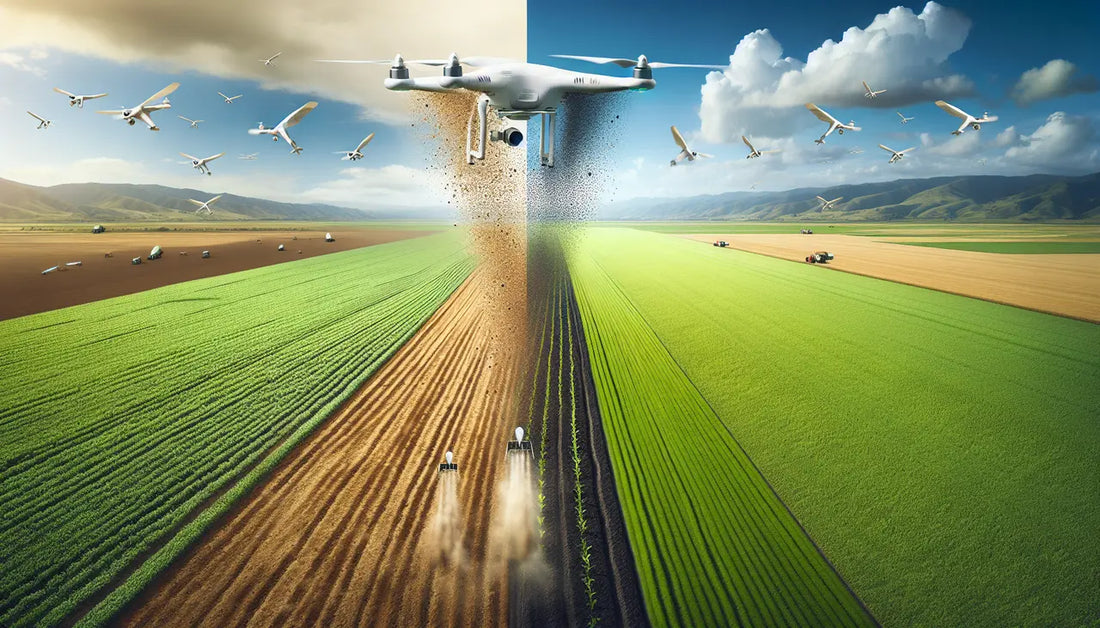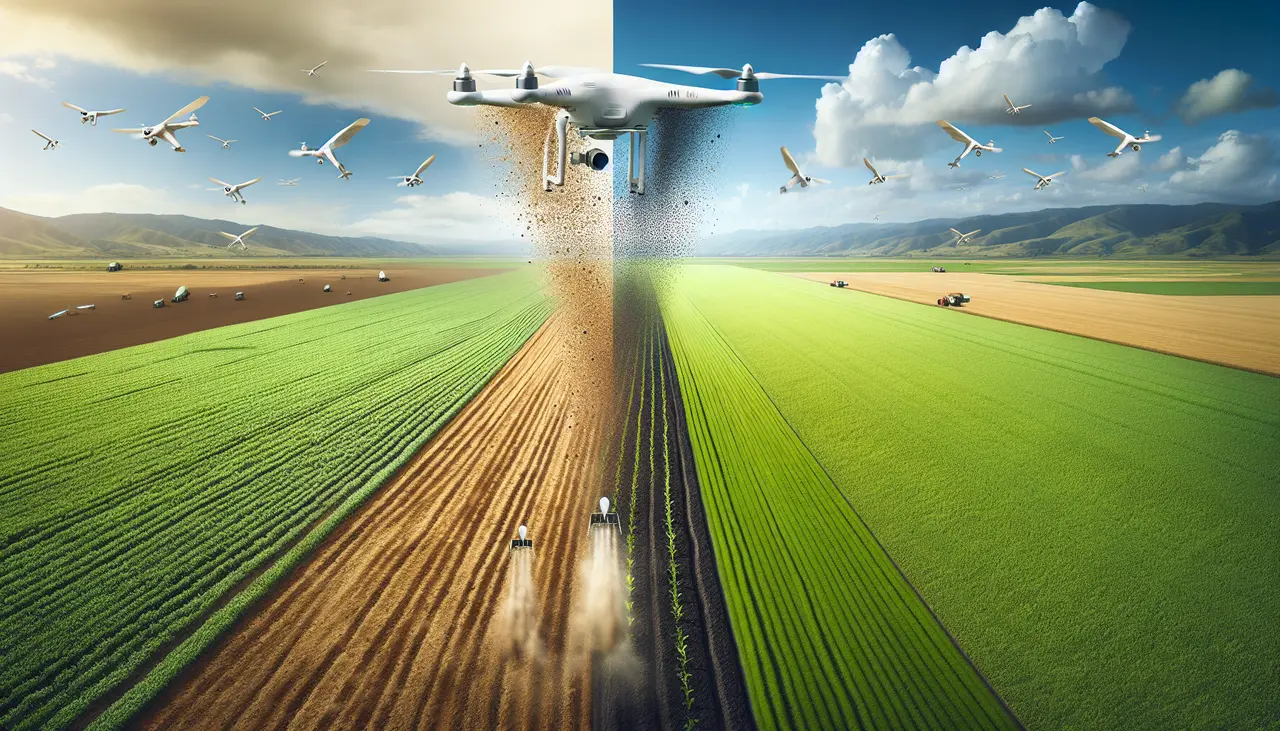
The Benefits of Drone Planting for Sustainable Agriculture Practices
Share
Introduction to Drone Planting in Agriculture
Drone planting is a game-changer in the field of sustainable agriculture. It’s all about using drones, or unmanned aerial vehicles, to plant seeds. This method offers a fresh perspective on farming that is both efficient and eco-friendly. So, why should we care about drone planting? First off, it’s fast. Drones can cover large areas quickly, meaning planting can be done in a fraction of the time it takes using traditional methods. Also, it’s precise. Drones can be programmed to plant seeds at specific locations and depths, ensuring optimal growth conditions. Plus, this precision reduces the need for fertilizers and pesticides, which is better for the environment. But that’s not all. Drone planting requires less labor, cutting down on costs and making farming more accessible. It’s particularly useful in hard-to-reach areas or places where planting conditions are tough for humans. In short, drone planting is pushing agriculture into a more sustainable and efficient future. It’s not just about planting seeds; it’s about planting hope for a healthier planet.
Drone Planting: An Overview of the Technology
Drone planting is changing the game in sustainable agriculture. At its core, this technology relies on drones, which are essentially flying robots, to plant seeds across large areas of land. The drones are equipped with special systems for dropping seeds at precise locations. This method is not only fast but also requires less labor compared to traditional planting techniques.
Key components of drone planting technology include a GPS system for impeccable accuracy, autopilot modes to navigate vast areas, and specialized seed pods that ensure each seed has the best chance to grow. This tech is particularly useful for planting in hard-to-reach areas or regions where the soil is not easy to access on foot or with heavy machinery.
In practice, drone planting technology follows a few simple steps: First, the area to be planted is mapped using the drone’s GPS. Then, flight plans are created to cover the entire planting zone efficiently. These plans are automated, ensuring every inch of the targeted area gets covered. Finally, the drones take off, dispersing seeds across the designated zones.
What makes drone planting stand out for sustainable agriculture is its precision and efficiency. Using drones cuts down on the need for heavy tractors and machinery that compact the soil and emit CO2, making it a friend to both the earth and the farmer’s budget. Plus, the ability to reach difficult terrains without disturbing the natural landscape keeps ecosystems more intact.
The Role of Drone Planting in Sustainable Agriculture
Drones are changing the game in sustainable agriculture, making it easier and more efficient than before. Here’s how they’re doing it. First off, drones can plant seeds from the sky, covering large areas much faster than manual planting. This means less foot traffic on the ground, which reduces soil compaction. Healthy soil equals healthier plants. Not to mention, drones can get to places that are hard for people or tractors to reach. Think about steep hills or remote areas. Then there’s the precision. Drones can drop seeds at the exact right spot, using less seed and ensuring each one has the best chance to grow. This precision leads to less waste and more growth. Also, they work with data. Drones scan the land, collecting information about soil conditions, moisture levels, and more. This helps farmers make smarter decisions about where and what to plant, improving yields and reducing the need for chemicals. All of this adds up to a big win for the environment. By using resources more efficiently and supporting the health of the soil, drone planting plays a crucial part in sustainable agriculture. It’s about doing more with less, keeping our planet healthy for future generations.
Environmental Benefits of Adopting Drone Planting
Drones have revolutionized farming methods, making it possible to plant seeds with precision, efficiency, and less effort. This has a direct positive impact on the environment. First off, drones drastically reduce the need for heavy machinery on the farm. This means less soil compaction, a problem with traditional tractors that can harm plant growth and decrease soil health over time. Soil stays healthier and more fertile, supporting diverse ecosystems.
Another key benefit is the significant cutback in fuel consumption. Traditional planting methods require machinery that runs on fuel, emitting harmful gases into the atmosphere. Drones, being electric, slash these emissions, contributing to cleaner air.
Furthermore, drone planting allows for more precise seed placement. This precision leads to a higher germination rate and optimal plant growth, reducing the need for excess seeds and minimizing waste. It also means that less water and fewer chemicals are used, as each plant gets exactly what it needs to thrive. This careful resource management aids in protecting local waterways from runoff pollution, a common issue with over-fertilization and pesticide use in traditional farming.
In summary, by adopting drone technology, farmers are not only making their work easier but are also protecting the environment. Reduced soil compaction, lower emissions, precise planting, and efficient use of resources are just a few ways drone planting supports sustainable agriculture.
How Drone Planting Reduces Water and Chemical Usage
Drones are changing the game in sustainable agriculture, especially when it comes to using water and chemicals more efficiently. Here’s the breakdown. First off, drones are super precise. They can pinpoint exactly where seeds need to go, which means farmers don’t have to blanket an entire field with water or chemicals. This precision saves a ton of water, which is critical in areas prone to droughts or where water is scarce. Plus, because drones can target specific areas, they help reduce the amount of fertilizer, pesticides, and herbicides used. This not only saves water but also cuts down on the chemical runoff that can harm local ecosystems. In short, drones make farming smarter, not harder, using technology to do more with less.
Increased Efficiency and Coverage with Drone Planting
Drone planting boosts efficiency and coverage far beyond traditional methods. How? These flying machines cover large areas quickly, planting seeds with precision that human hands or heavy machinery can’t match. This means less time in the field, lower labor costs, and the ability to reach remote or difficult terrains without a sweat. It’s not just about speed, though. Drones can be programmed for smart planting, dropping seeds at the perfect depth and spacing for optimal growth. This smart approach cuts down on waste, ensures every seed has its best shot, and even helps with overcrowding or underplanting issues. So, whether it’s a vast commercial farm or a small community project, drone planting ushers in a new era where more ground can be covered, with less effort and better outcomes.
The Impact of Drone Planting on Crop Yield and Health
Drone planting boosts crop yields and health in several notable ways. First off, drones plant seeds with startling precision, avoiding the waste that often comes with traditional sowing methods. This precision leads to more even crop growth and healthier plants because each one has its own space and resources. Drones also get seeds into the ground faster than human hands or traditional machinery, which means plants get a head start in growing. This can be especially important in areas where the growing season is short. Furthermore, drones can be equipped to carry and distribute the exact amount of nutrients each plant needs directly to the soil around it, reducing the need for broad-spectrum fertilizers and increasing the efficiency of nutrient use. In short, when it comes to planting, drones offer a triple boon: They make it faster, more accurate, and healthier for the crops. All these lead to a better yield come harvest time, which is great news for sustainable agriculture.
Financial Savings and ROI for Farmers Using Drone Planting
Using drones for planting crops cuts down on the heavy costs that come with traditional planting methods. Here’s the deal: renting or buying large farm machinery like tractors and planters is expensive. Beyond the upfront cost, you’ve got maintenance, fuel, and the need for skilled operators. Drones, on the other hand, are a buy-once kind of deal. You invest in the drone, and minor upkeep is all that’s needed to keep it flying.
Now, when we talk about the return on investment (ROI), drones shine bright. They plant seeds way faster than humans or tractors, meaning a farmer can get a lot more done in less time. This speed doesn’t just save money; it gets crops growing quicker, leading to potentially earlier harvests and sales. Plus, drones don’t just randomly scatter seeds. They use cool tech to place them at the perfect spot and depth for the best growth, which can lead to better crop yields. More crops mean more money. It’s simple.
The kicker? Drones also gather data while they work, helping farmers make smarter decisions about their land, which can increase crop production and reduce wasted resources. Over time, this data-driven approach can lead to substantial savings and higher profits.
So, with an initial investment in drone technology, farmers can drastically cut traditional planting costs, boost crop yields, make informed decisions with real-time data, and see a strong ROI. It’s a win-win for the farmer and the environment.
Challenges and Limitations of Drone Planting in Agriculture
Drone planting is cutting-edge in agriculture, but it’s not all smooth flying. First, the high cost of drones can be a barrier for many small-scale farmers. These machines are expensive, and not everyone can afford the initial investment. Then, there’s the technical skills required. Operating a drone isn’t easy and requires specific knowledge and training. Without these skills, it’s hard to make the most out of this technology. Weather is another challenge. Drones are sensitive to conditions like strong winds, heavy rain, or extreme heat, limiting when and where they can be used. Also, battery life is a hurdle. Drones can only fly for a limited time before needing a recharge, which can slow down the planting process. Lastly, legal and regulatory issues can be a thicket. Different regions have various rules about drone usage, and navigating these can be tricky. Despite these challenges, the potential benefits of drone planting for sustainable agriculture are significant, pushing the envelope on what’s possible in farming technology.
The Future of Farming: Advancements in Drone Planting Technology
Drones are changing the game in farming. They’re not just flying cameras anymore; they are your future farmhands. Imagine a farmer controlling a fleet of drones, each one planting seeds with precision. This isn’t a scene from a sci-fi movie, it’s happening right now. Advancements in drone planting technology mean we can plant seeds faster, with more accuracy, and in places where traditional methods wouldn’t dare tread. Why does this matter? Well, for starters, drones can cover vast areas in a fraction of the time it would take humans or heavy machinery. This speeds up the planting process, allowing for more efficient land use and less human labor. Plus, drones are precise; they can plant seeds at the exact depth and spacing required for optimal growth, reducing seed waste. And let’s not overlook the accessibility factor. Drones can reach remote or difficult terrains, such as steep hills or areas with poor soil conditions, opening up new possibilities for agricultural expansion without the need for deforestation or significant land alteration. This tech isn’t just about planting seeds. It’s about making sustainable farming practices accessible and efficient, ensuring that as our global population grows, our ability to produce enough food grows with it, in harmony with the environment. The future of farming looks sky-high—literally, with drones leading the way.

